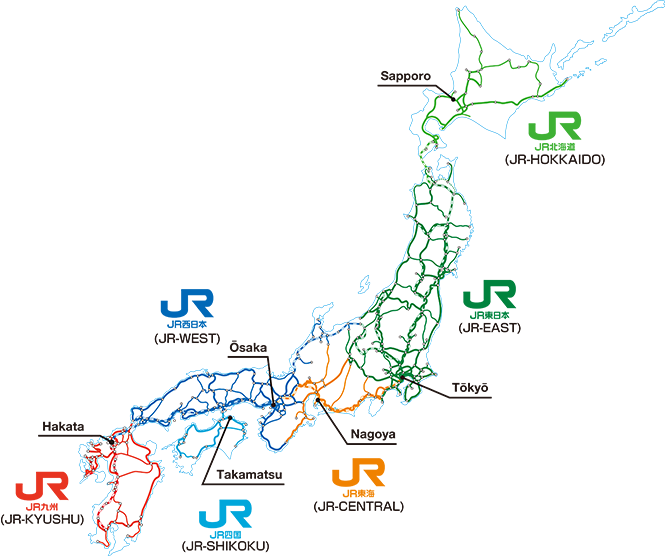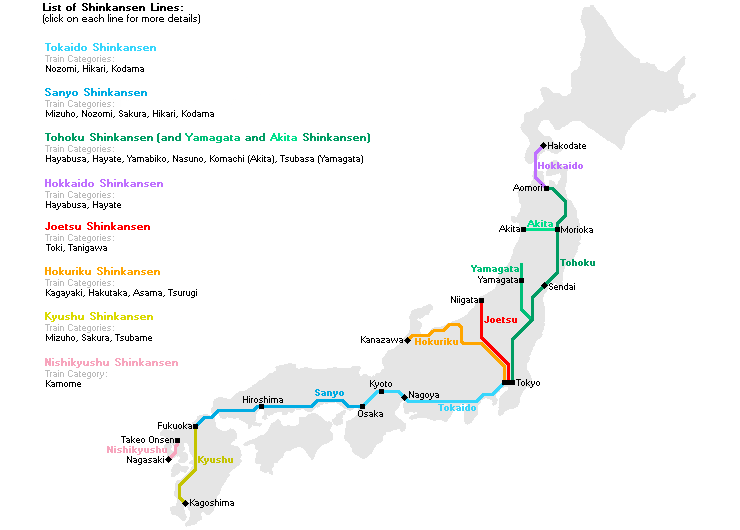Japan is a country like no other. Aside from its wonderful scenic views and iconic architecture, the country offers a world class transportation system.
Amongst these are the world famous Japanese bullet trains or shinkansen. In this guide we aim to uncover the steps you need to take to travel the shinkansen network with your Japan Rail Pass (JR Pass).
1. What is the Japan Rail Pass (JR Pass)?

First of all, when travelling to Japan, the first thing that gets mentioned a lot is the Japan Rail pass or JR Pass for short. The pass is an absolute must for anyone considering visiting several cities during their stay in Japan.
The best way to travel domestically is by far the bullet train. Japan’s renowned high-speed trains, known as shinkansen or bullet trains, exhibit a harmonious blend of aesthetics, comfort, convenience, and speed.
These exceptional marvels of transportation achieve speeds of up to 320 kilometres (200 miles) per hour, making them globally admired.
Operating on dedicated tracks distinct from other train routes, they stand as a remarkable testament to engineering prowess.
Whilst you can buy individual tickets as you would in any country, the JR Pass was created to streamline the experience and provide an economical way for foreign tourist only to travel around the country.

The JR Pass is a train pass similar to Interrail/Eurail Pass in Europe offering inclusive travel across Japan or certain zones within Japan.
The pass belongs to the Japan Rail network, Japan’s largest train network. Unlike Interrail/Eurail, the JR Pass can only be bought in consecutive days increments.
The pass comes in 7-, 14-, and 21-day options. If you need to travel 28 days then you would need a 7 and a 21 day passes.
Therefore, it’s paramount that you consider well your options and plan ahead, once the pass is activated the countdown starts. We wrote an extensive article of our Japan 2023 trip where we cover our itinerary using a 7 day pass.
Another important thing to note is that the pass itself is a paper ticket. Once issued it can’t be reissued hence you need to make sure you don’t lose it. We actually did see a couple who lost their passes and they had to buy new ones at the station.
2. Where to Buy the JR Pass?

The JR Pass proves to be incredibly user-friendly; all you need to do is ensure you purchase it in advance while in your home country, as it is exclusively available to visitors.
Although it was possible to buy upon arrival at select ticket offices in Japan until March 31, 2024, as of today you can only buy the pass exclusively outside Japan whether online or in person. Online purchases will be more cost-effective as you avoid higher in-person fees. Here you can see where you can buy in person the pass.
The JR Pass prices come in various options, (as of October 2024) each valid for consecutive days rather than just travel days:
- 7 days: 50,000 JPY (70,000 JPY for a Green Pass)
- 14 days: 80,000 JPY (110,000 JPY for a Green Pass)
- 21 days: 100,000 JPY (140,000 JPY for a Green Pass)

The Green Pass, akin to a first-class option, may not be necessary since Japan’s trains are already impressive, unless you seek added luxury.
When considering JR Pass ordinary vs green, traveling in green cars can be more cumbersome for spontaneous travellers, as seat reservations are mandatory in advance, requiring a visit to the ticket office or automatic reservation machines.

In ordinary cars, you can simply board and take any available seat.
Aside from the standard and green JR passes, regional passes are available for those not traversing the entire country, providing additional cost savings. These region-specific passes typically range from one to seven days.
JR passes can be purchased for six regions:
- JR East (for the main island)
- JR West (for the main island)
- JR Central (for the main island)
- JR Hokkaido (for the northern island)
- JR Kyushu (for the southwestern island)
- JR Shikoku (for the southeastern island)
If your focus is on a specific region, consider a JR regional pass; for comprehensive countrywide access, opt for the regular JR Pass. As a first-time visitor to Japan, the regular JR Pass is likely your best choice, covering all major destinations.
The most convenient method to obtain a Japan Pass is through online ordering, with numerous official providers available. We bought our passes using Klook and had the vouchers delivered home hassle free.
Book: JR Pass

Upon purchasing the pass, you’ll receive a stamped “exchange order” by mail, indicating a date. This document must be presented in Japan to receive your actual pass, so be sure not to forget it at home.
Upon arrival in Japan, you exchange the provided order at a JR office for the JR Pass. Ensure you have your original passport (not a photocopy) with you, as they verify the presence of a temporary visitor stamp. The JR Pass is exclusively for visitors, and the verification process is fairly stringent.
You have a three-month window, starting from the date on the exchange order, to pick up your JR Pass. However, the pass usage doesn’t need to commence on the same day you collect it.

For instance, if you wish to pick up the pass upon arrival but plan to spend time in Tokyo before exploring the rest of the country, you can select any date within one month of exchanging the order as your starting date. Keep in mind that once the pass is issued, the starting date cannot be changed.
Once in possession of your pass, obtaining tickets becomes worry-free, as you can smoothly pass through automatic turnstiles.
In addition to access to shinkansen and other trains, the JR Pass provides entry to:
- Local buses operated by JR (e.g., the tourist loop bus in Hiroshima or JR buses around Sapporo)
- Ferries operated by JR (such as the one from Hiroshima to the island of Miyajima)
- JR lines in metropolitan areas (such as Tokyo and Osaka)
- Free seat reservations (normally costing around 330-930 JPY)
However, the JR Pass is not applicable to:
- The Nozomi and the Mizuho shinkansen lines
- Japanese citizens or residents, including foreigners working in Japan (restricted to those with a tourist visa).
3. How to Use the JR Pass?

It’s worth noting that several JR trains are included in the pass. The most popular is the shinkansen (bullet) train, which is the fastest train and goes to nearly every destination and region.
The next fastest is the tokkyu (limited express). The kyuko (express) train comes next, followed by the kaisoku (rapid) and kakueki-teisha or futsu-densha (local trains that make every stop).
Once you’ve booked your JR Pass you might be tempted to reserve seats ASAP, however, that is not possible, unless you book via jrpass.com. This is because you need to have an active JR pass ticket, not the exchange order.
This shouldn’t put you off and in general, unless you go during busy holiday period, you will always find seats.
Typically, once you have the actual pass, using it is a breeze. All you have to do is go through the appropriate ticket gates or show the pass to the driver at JR stations and on bus services.
Like what you are reading? Why not join us for other journeys by subscribing to our newsletter:
3.1 JR Zones and why they are important?

In general terms, similar to the Interrail Pass, you can get the JR Pass for the whole of Japan or just for specific zones in Japan.
This could be good if you are planning to stay more just in one region e.g. JR West. Typically if you are looking to do 2 regions or more, then a country wide pass is more cost effective.
A good map detailing the various zones can be found above. Alternatively, a good article discussing in more depth each zone can be found here written by the Japan-Guide.com team.
3.2 How to Book a Seat Reservation on a Bullet Train (Shinkansen)

If you are wondering how to book shinkansen tickets or better said reserve seats on a Japanese bullet train, then in this section we aim to give you the confidence of doing this.
If you’ve bought the JR Pass, you probably bought it so you can use the Shinkansen services. Unless you booked your tickets through jrpass.com then your options for reserving seats are as follows:
- Green ticket machines in any station
- Dedicated JR offices typically found at any Shinkansen station
As mentioned before, seat reservations are not mandatory, they are more important if you want to seat together if travelling in a group.
What are the steps in booking a seat reservation on the Shinkansen?
Step 1:
The first step in reserving a seat on a Shinkansen service is knowing which service you will take. Below is a map of bullet trains in Japan.

Step 2:
Once you’ve identified the line and station you want to go to then go to Jorudan Transit Planner app and input the stations.
As a tip, you can also select the dedicated JR Pass Search found on the top right corner of the screen. This will filter out any services that aren’t valid with your JR Pass.
Step 3:
Make a note of the dates and times with departing station and head over to a JR Office. An assistant there will help you book those seat reservations.
Alternatively, you can use the green ticket machines found at most stations and book it yourself on the spot.
In either cases, have your passport and JR Pass ticket with you.
Step 4:
Board the train. You will only need to present the JR Pass at the ticket machines when entering the platform.
Note: The seat reservation can be cancelled if you change your mind. Alternatively, you can just board any other train and go in unreserved cars of the train. Typically 30% of the train’s seats will be for unreserved passengers.
Additionally, you won’t be able to make two reservations on the same day on the same service. You will have to cancel the original.
3.2.1 Bringing your Luggage on the Shinkansen

This topic is particularly confusing as many articles out there erroneously specify that you need a seat reservation when travelling with (any) suitcase.
To be clear, you don’t need a seat reservation to travel with the bullet train in Japan even if you have luggage. The only time you need a seat reservation is when the L+H+D of your suitcase exceeds 160 cm.
E.g. for a normal 23kg carrying suitcase it won’t surpass those limits. But to be sure, you can just measure it and make sure that the height + length + depth of the suitcase when added up, don’t go over 160 cm.
Oversized luggage is considered between 160 cm and 250 cm. You can read more on JR’s luggage guidance here.
4. Is the JR Pass worth it?

While the initial cost of purchasing a pass might surprise you, the savings during your journey are substantial—even with visits to just 2-3 cities.
If you follow our 2 week Japan Itinerary then a 7 day pass at 50 000 JPY will save you 20% off your JR services travel. Greater savings can be achieved with the 14 and 21 day passes.
Furthermore, consider these examples of one-way shinkansen tickets with non-reserved seats in the “ordinary” class:
- Tokyo-Hiroshima: 18,380 JPY
- Tokyo-Kyoto: 13,320 JPY
- Tokyo-Fukuoka: 23,390 JPY
- Kyoto-Hiroshima: 10,570 JPY
- Kyoto-Osaka: 4,230 JPY
- Hiroshima-Fukuoka: 9,000 JPY
- Nagano-Kanazawa: 8,440 JPY
- Tokyo-Yokohama: 3,210 JPY
- Hakodate-Tokyo: 23,500 JPY
It’s evident that just one longer-distance journey from Tokyo, like to Hiroshima or Fukuoka, can justify the pass’s cost. And you’ll likely use it even more!
Even if you’re not opting for bullet trains, the pass remains sensible. For instance, a local train trip from Kyoto to Tokyo is approximately 8,360 JPY—versus 13,320 JPY for the bullet train prices.
However, the local journey takes nine hours with several transfers, making it less ideal, especially for time-constrained travellers. The cost savings often don’t justify the inconvenience.
Opting for bullet trains allows you to relish the high-speed experience as you seamlessly travel from one incredible destination to another!
Don’t forget to explore online options for purchasing shinkansen tickets, considering bullet train prices for Tokyo to Kyoto and other routes like Tokyo to Osaka Shinkansen services.
Book: JR Pass
Ready to book? Below are some recommendations to get your trip started:
- Flights – we use flight aggregators such as Skyscanner and Google Flights to find the best options. You can find more information about finding cheap flights here.
- Accommodation – would recommend booking your accommodation through an aggregator such as Booking.com or Trip.com to get the best rates. We also use TripAdvisor to read reviews.
- Transport – consider DiscoverCars for car renting or if you rely on public transport, you can use Omio for trains, coaches, ferries, airport transfers and even flights.
- Activities – a great option is GetYourGuide, Klook or Viator for tours, excursions, experiences and tickets to many tourist attractions.
- Travel money – we have Starling Bank accounts (UK residents only) with 0% fees on FX and a good Mastercard exchange rate. Revolut is another good option.
- Travel insurance – check SafetyWing for travel medical insurance that works for you and your specific needs.
- Internet abroad – with Airalo or Nomad you can access a wide range of eSIMs (digital SIM cards) available for different countries and regions.
- Luggage storage – if you need to store your bags whilst exploring the destination, you can use Radical Storage to find your closest luggage storage and enjoy your journey until the very end.
As an Amazon Associate and member of various other affiliate programmes, some of the links in this article are affiliate links, meaning at no additional cost to you, we will earn a commission if you click through and make a purchase.
Like what you’ve read? Subscribe to our blog by adding your email address below. You’ll be the first to hear about new destinations and articles we publish!
Are you interested in travelling? Check out our Facebook page and other social media for regular tips and recommendations on how to travel and where to go!


